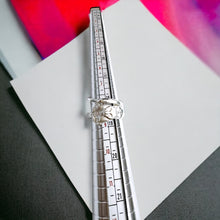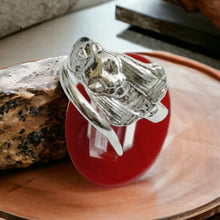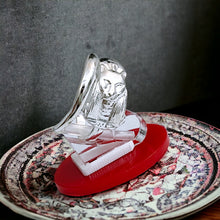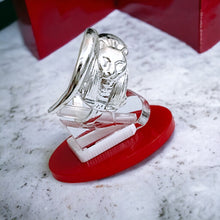
The Silver Goddess Sekhmet Adjustable Ring pays homage to the ancient Egyptian deity Sekhmet, embodying power and protection. Crafted with sterling silver, it reflects centuries of reverence for this lion-headed goddess, believed to possess both healing and destructive qualities. Adjustable to fit any finger, it seamlessly blends history with contemporary style.
- History: Inspired by ancient Egyptian deity, Sekhmet, known as a warrior goddess.
- Spiritually: Represents power, protection, and strength.
- Talisman: Believed to ward off negativity and bring courage.
- Handmade: Crafted with care and attention to detail.
- Healing: Associated with promoting resilience and vitality.
- Material: Made of sterling silver, known for its purity and durability.
- Symbolism: Depicts the lioness-headed goddess, symbolizing ferocity and guardianship.
- How to Wear: Adjust the ring to fit comfortably on any finger, carry its energy throughout the day.
History Side For Those Who Are Interested
Sekhmet, a prominent deity in ancient Egyptian mythology, emerged as one of the most revered and feared goddesses within the pantheon. Her origins can be traced back to the Early Dynastic Period (c. 3100–2686 BCE) of ancient Egypt, although her cult reached its zenith during the New Kingdom (c. 1550–1070 BCE).
Sekhmet's name translates to "the powerful one" or "the mighty." She was depicted as a lioness-headed woman, symbolizing both ferocity and protection. Sekhmet was closely associated with war, destruction, healing, and, paradoxically, with maintaining cosmic order (ma'at). She was often portrayed wielding the ankh, the symbol of life, or the papyrus scepter, signifying authority.
The mythology surrounding Sekhmet intertwines with that of Ra, the sun god. According to legend, Ra grew frustrated with humanity's disobedience and sent Sekhmet to punish them. However, Sekhmet's bloodlust became uncontrollable, threatening to annihilate all of humanity. To prevent catastrophe, Ra tricked Sekhmet by dyeing beer red to resemble blood. Believing it to be the blood of her enemies, Sekhmet drank it and became intoxicated, eventually falling asleep. This myth highlights Sekhmet's dual nature: a protector of Ma'at and a bringer of destruction.
Despite her fearsome reputation, Sekhmet was also revered as a goddess of healing and medicine. Temples dedicated to her often included infirmaries where priests and priestesses practiced medicine, invoking her aid in curing illnesses and averting epidemics. She was believed to possess the power to ward off pestilence and disease, making her a crucial figure in ancient Egyptian medicine.
Sekhmet's worship was widespread throughout Egypt, with her cult centers located primarily in Memphis, Luxor, and Thebes. The most famous temple dedicated to her is the Temple of Mut at Karnak, where she was worshipped alongside her consort, the god Ptah, and their son, the moon god Khonsu.
As Egypt's political landscape evolved, so did the prominence of various gods and goddesses. With the decline of the New Kingdom, Sekhmet's cult gradually waned, although she continued to be venerated in smaller cults and as part of broader religious practices.
In modern times, Sekhmet remains an enduring symbol of power, protection, and the delicate balance between destruction and renewal in ancient Egyptian mythology. Her imagery and symbolism continue to inspire artists, scholars, and spiritual practitioners worldwide, keeping her legacy alive through the ages.















